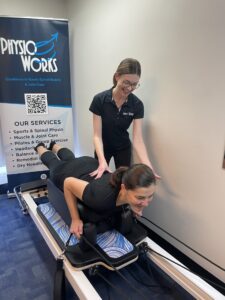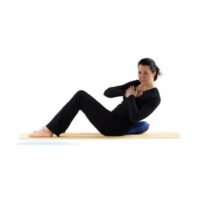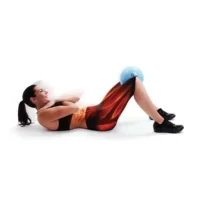Pilates
Article by Erin Hickey
Pilates: Strengthening Your Core for a Pain-Free Life
Pilates is a form of exercise that focuses on activating your deep core muscles to safely control various movements. This exercise can range in difficulty and skill level, with specific equipment and goals. At select PhysioWorks clinics in Brisbane, we offer clinical Pilates tailored for individuals with back, neck, or shoulder pain, and movement dysfunction.
Clinician-Led Pilates
Clinical Pilates, led by trained physiotherapists, includes exercises that train your core muscles to activate during dynamic body movements. This approach ensures that you perform exercises safely and effectively, reducing the risk of injury and promoting better rehabilitation outcomes.
1 on 1 Reformer Pilates

For a more personalised approach, consider 1 on 1 reformer Pilates sessions. These sessions use a specialised piece of equipment called a reformer, which provides resistance and support to enhance your Pilates workout. With individual attention from a trained physiotherapist, you can focus on your specific needs and goals, ensuring each movement is performed correctly and safely. This personalised training can be especially beneficial for those with specific pain or movement issues, offering a targeted and effective way to improve core strength and overall stability.
The Importance of Pilates for You
Your core muscles play a crucial role in providing stability at each spine segment during movement. Research indicates that these muscles often become underactive or “switch off” in people with back pain. While initial episodes of back pain may resolve, 80% of those affected will experience recurring pain within a year. Core stability retraining is essential to the rehabilitation process and significantly reduces the risk of re-injury. These muscles must activate not only during movement but also during everyday activities such as rolling over in bed, bending, reaching, and sitting for long periods.
Pilates effectively retrains all your core muscles through various movements and can be tailored to meet your individual needs. This flexibility makes it a valuable tool in managing and preventing pain.
Who Should Do Pilates?
Not everyone is suited for Pilates. Overly aggressive exercises that exceed your body’s capabilities can lead to pain and injury. At PhysioWorks, we frequently treat patients who have exacerbated their back pain due to poorly managed Pilates classes.
Exercises like Pilates, yoga, and gym strengthening demand a lot from your core stability system. If your core muscle recruitment order is abnormal, your injury risk increases with the difficulty of the exercises. Building a strong foundation with proper core stability is essential. Without it, your body is like the Leaning Tower of Pisa – unstable and prone to problems. However, recruiting the deeper core muscles before the superficial layers ensures a stable and pain-free body, much like constructing a skyscraper on a solid foundation.
Link Between Pilates and Core Stability
The core stability concept began in the 1920s with Joseph Pilates, who developed exercise regimes focusing on the deep trunk muscles. He called it a ‘girdle of strength,’ recognising the importance of these muscles long before modern anatomical research confirmed their supportive effects.
Core stability training targets the smaller and deeper back and stomach muscles. Once activated, these muscles control the spine’s position during dynamic body movements, enhancing stability and reducing pain.
Conclusion
Pilates is more than just an exercise; it’s a method to strengthen your core, improve stability, and prevent pain. By engaging in clinician-led Pilates, you ensure safe and effective workouts tailored to your needs.
What to Do?
For professional advice, consult your physiotherapist. They can guide you in incorporating Pilates into your routine safely and effectively.
Rochedale - Call 38410277
Book Online: RochedaleSalisbury - Call 32751044
Book Online: SalisburySandgate - Call 32691122
Book Online: SandgatePilates FAQs
1. What is Pilates? Pilates is a form of exercise that focuses on strengthening your deep core muscles to control various movements safely.
2. How does Pilates help with back pain? Pilates retrains your core muscles, which provide stability to your spine, reducing the risk of recurring back pain.
3. Can anyone do Pilates? Not everyone is suited for Pilates. It’s important to have a physiotherapist guide you to avoid pain and injury from overly aggressive exercises.
4. What is clinical Pilates? Clinical Pilates, led by physiotherapists, includes exercises tailored to individuals with specific pain and movement dysfunctions, ensuring safe and effective workouts.
5. Why is core stability important? Core stability is crucial for spine stability during movement, reducing the risk of injury and pain.
6. How often should I do Pilates? Frequency varies based on individual needs. Consult your physiotherapist to determine the best routine for you.
Related Articles
- Pilates for Back Pain Treatment
Discover effective treatment options for back pain, including Pilates techniques. - Pilates for Shoulder Pain Treatment
Learn about the causes of shoulder pain and how physiotherapy can help. - Neck Pain Treatment
Find out how to manage and treat neck pain with physiotherapy. - Core Stability Exercises
Explore exercises that improve core stability and reduce pain. - Benefits of Physiotherapy
Understand how physiotherapy can improve your overall health and wellbeing. - Posture Correction
Learn techniques to improve your posture and prevent pain. - Sports Injury Management
Find out how physiotherapy can help manage and recover from sports injuries. - Rehabilitation Exercises
Discover exercises that aid in the rehabilitation process. - Chronic Pain Management
Learn strategies for managing chronic pain with physiotherapy. - Preventing Injuries
Understand how to prevent injuries with proper exercise techniques and physiotherapy. - Pilates for Beginners: A Guide
Discover the basics of Pilates and how to start safely. - The Benefits of Pilates
Learn about the various health benefits Pilates offers. - Pilates for Back Pain
Explore how Pilates can help alleviate back pain and improve core strength.





















